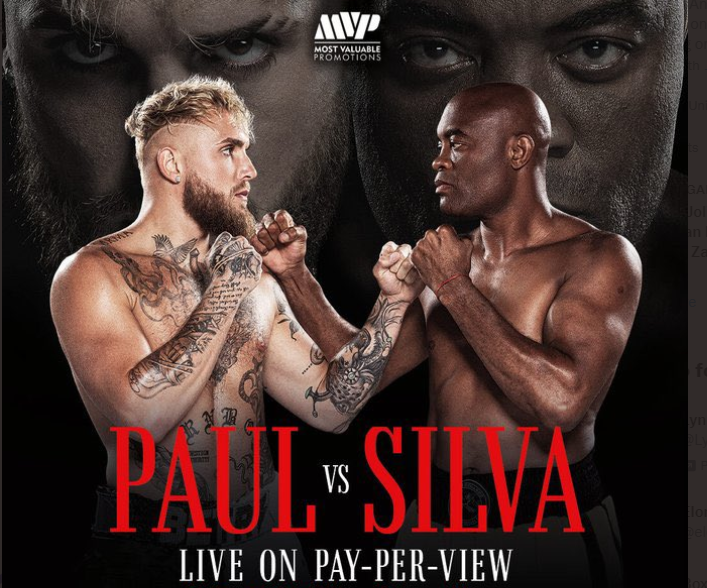Featured Articles
Paul vs. Silva: A Circus on Steroids or a Bonafide Athletic Competition?

Paul vs. Silva: A Circus on Steroids or a Bonafide Athletic Competition?
In 1958, RCA Records came out with a record album depicting then-23-year-old Elvis Presley, in a preposterous gold lame suit, entitled 50,000,000 Elvis Fans Can’t be Wrong. OK, so the kid from Tupelo, Miss., could sing, but his rocket-to-the-moon rise in popularity as the king of rock ’n’ roll was particularly amazing considering that just a few years earlier he was a low-paid truck driver who counted himself fortunate to land an occasional gig shaking his hips at a Deep South county fair.
No one would yet dare to describe 25-year-old Jake “The Problem Child” Paul as a pugilistic equivalent of Presley, but there are certain numbers that suggest the YouTube icon from Cleveland already is encroaching on the fringes of late 1950s Elvis territory and pressing for more. By the spring of 2014, the younger of the two boxing Paul brothers – Logan is 27 — had amassed 5.3 million internet followers and two billion views on the discontinued Vine app. When he signed a multi-fight contract with Showtime in May 2021, Paul could boast of a whopping 20.4 million YouTube followers. There are future mortal-lock inductees into the International Boxing Hall of Fame who would just about sell their souls for that humongous a fan base, or even its smaller but continually expanding boxing subset, which is why everyone interested in the sport will be watching to see how Paul (officially 5-0 with four knockouts) fares in his Showtime pay-per-view bout ($59.95) with aging martial arts legend Anderson “Spider” Silva (3-1, 2 KOs) Saturday night at the Desert Diamond Arena in Glendale, Ariz. The eight-round cruiserweight main event will be staged under boxing rules.
As always, Paul, whose unapologetic and unrestrained demeanor outside the ring constitutes a significant part of his notoriety, pulled no punches with his remarks at a press conference to announce what figures to be his most difficult challenge in his bid to eventually be recognized as a legitimately skilled fighter and not just a sideshow curiosity.
“My previous opponents were all dickheads,” Paul said with the lack of subtlety that has marked his incursion into an arena in which flung expletives are commonplace. “Anderson Silva is the nicest guy in the world and we love him. If my opponent is a dickhead, I’m gonna treat him as a dickhead and beat his f—— ass. I think people have seen that side of me, but I respect this man. I’m still gonna knock him out, but respectfully knock him out.”
Paul’s low estimation of the boxing capabilities of his previous victims is entirely justified. Ali Eson Gib, former NBA player Nate Robinson, Ben Askren and Tyron Woodley all were making their pro debuts when they lost to the Problem Child, with Woodley coming back for a rematch in which he was knocked out in the sixth round. A murderers’ row it wasn’t. Silva, however, has sterling credentials; the Brazilian-born southpaw at one time was widely regarded as the best MMA fighter in the world, and his most obvious attribute during his heyday was his striking ability. If he nailed the other guy with a punch that landed flush, he likely was going down and out. But Silva is 47 now, and Paul is not the only foe he will be confronting when the opening bell rings. Age is the silent thief that comes in the night, siphoning bits and pieces from even a great champion’s compendium of positive attributes. Former middleweight and light heavyweight champion Bernard Hopkins can attest to that; he was just weeks shy of his 52nd birthday when he suffered the only loss inside the distance of his 28-year pro career, against 27-year-old Joe Smith Jr. on Dec. 17, 2016. B-Hop is absolutely certain that even a moderately younger and less-depleted version of himself would have defeated Smith, but no matter the outcome Saturday night he can’t compare his final ring appearance to a matchup he considers fraudulent.
“This is a total attempt to hoodwink the public,” sneered Hopkins who, like Paul, is temperamentally disinclined to tone down the chatter when his ire is up. “I do believe the boxing community is too smart to legitimize something like this. This fight is a circus on steroids.
“Showtime should be ashamed to promote this as a real event based on Jake Paul’s opponent. It’s the lowest of the low. Me and Joe Smith was a legitimate fight. Paul’s is not. This nonsense, this buffoonery, has got to stop.”
All right, that is one opinion. It is not the only one. Taking his turn at the figurative podium is Stephen Espinoza, president of Showtime Sports, whose company has long been involved in high-level boxing and, as of 2021 when it signed him to a multi-fight contract, the perhaps grand experiment that is Jake Paul. Maybe Paul throwing hands with the Anderson Silva of the here and now is not quite the acid test it might have been years ago, but it nonetheless stands as a major hurdle that must be cleared on Paul’s way to bigger and better things.
“The commitment that he made to us when we started into business with him is that he would progressively increase the risk with each fight. There’s no question he’s done that,” Espinoza said. “But to be completely candid, there were more than a few members of Jake’s team that were opposed to the Silva fight. This man is a legendary combat sports athlete with great striking ability who has already demonstrated a good amount of boxing skill.
“Look, I can be as much of a purist as anyone else in the sport, and I’ll confess I was initially a skeptic of the concept. But what converted me was, (a), watching his fights. It was apparent even in his early fights that Jake has a level of skill and enthusiasm that made me think that he could pull this off. Secondly, he has respect for the sport and the ambitions he has for the protection of fighters and expansion of the sport, even tutoring other fighters on how to use social media to their benefit.
“Clearly, he’s been interacting with his audience, learning from what they like. You don’t generate a fan base like his by accident. It’s calculated and part of a very intelligent plan. His fans are not people who picked up on a website six months ago and suddenly discovered him. He’s been gathering his supporters for more than a decade.”
Perhaps Espinoza is a visionary, part of a rare breed of soothsayers who recognize what the public wants before the masses want it, and caters to that need in its incubation stages. He recognizes past failures of similar ploys, such as when promoter Gary Shaw hitched his wagon to a menacing YouTube brawler named Kimbo Slice in an impossible quest to turn him into a heavyweight champion. But, hey, if something doesn’t work once or even twice, try, try again. The main requirement for a breakthrough is identifying just the right banner-carrier.
“I think Jake is a bit of a unicorn,” Espinoza continued. “He has the physical skill and talent, and the mental determination, to seriously undertake boxing and not as a fad or an attention-grabbing stunt. The usual procedure is to take a really talented, skilled boxer and make him popular, to make people care about him. This experiment is a little bit of the reverse. You take someone who already has a huge fan base, and also has certain physical abilities and athleticism, and make him into a serious boxer right in front of your eyes. I think it’s fascinating to watch.”
To his credit, Paul has been outspoken in his support of better pay and more recognition for boxers, especially previously underserved women boxers, and he has undeniably raised the profile of Amanda Serrano by having her appear on his cards. In doing so, there is mounting evidence he is drawing a younger demographic into the well of traditional boxing fans, a group that has been skewing older for some time.
“One of the questions at the start of this endeavor with Jake was, `Are these people just Jake Paul boxing fans, or can they become truly committed boxing fans? We’ve seen that question answered. These people coming in are becoming fans of the sport. I’ve seen it in Cleveland, a bunch of young kids clamoring for an autograph of a Puerto Rican female boxer (Serrano) who, as skilled as she is, largely toiled in obscurity for most of her career until Jake got more people interested in boxing.”
Espinoza also stresses that the investment in Jake Paul does not detract from the resources Showtime is putting and always has into the sport.
“Jake is not taking opportunities from anyone else,” Espinoza said. “Pay per view is all about eating what you kill. It’s not like we’re depleting our boxing budget and can’t put on three other championship fights. We’re able to do both, side by side, without compromising the long history of supporting championship-level fights that Showtime has been known for. That is not an either/or situation.”
So, what does the long view of Jake Paul look like? Maybe a quickie flameout, but maybe something far more intriguing. Maybe even as intriguing as it would have been had Elvis Presley, who played a boxer in 1962’s Kid Galahad, ditched his music career, took up the sweet science full-time and against all odds became a world champion. Elvis, who for years had dabbled in martial arts, did throw reasonably convincing overhand rights in that one, as Paul does now.
“Jake has the attributes to fight not just credible professional boxers, but contender-level and maybe even championship-level ones,” Espinoza said of the possible winning lottery ticket he hopes he has purchased. “Nothing would make him happier than in three years, five years, to look back and say, `No one thought I could do this. I’ve removed all questions about my boxing credibility.’ I think that’s the goal.”
Bernard Fernandez, named to the International Boxing Hall of Fame in the Observer category with the Class of 2020, was the recipient of numerous awards for writing excellence during his 28-year career as a sports writer for the Philadelphia Daily News. Fernandez’s first book, “Championship Rounds,” a compendium of previously published material, was released in May of last year. The sequel, “Championship Rounds, Round 2,” with a foreword by Jim Lampley, is currently out. The anthology can be ordered through Amazon.com and other book-selling websites and outlets.
To comment on this story in the Fight Forum CLICK HERE
-

 Featured Articles4 weeks ago
Featured Articles4 weeks agoAvila Perspective, Chap. 330: Matchroom in New York plus the Latest on Canelo-Crawford
-

 Featured Articles3 weeks ago
Featured Articles3 weeks agoVito Mielnicki Jr Whitewashes Kamil Gardzielik Before the Home Folks in Newark
-

 Featured Articles1 day ago
Featured Articles1 day agoResults and Recaps from New York Where Taylor Edged Serrano Once Again
-

 Featured Articles4 weeks ago
Featured Articles4 weeks agoCatching Up with Clay Moyle Who Talks About His Massive Collection of Boxing Books
-

 Featured Articles5 days ago
Featured Articles5 days agoFrom a Sympathetic Figure to a Pariah: The Travails of Julio Cesar Chavez Jr
-

 Featured Articles3 weeks ago
Featured Articles3 weeks agoMore Medals for Hawaii’s Patricio Family at the USA Boxing Summer Festival
-

 Featured Articles1 week ago
Featured Articles1 week agoCatterall vs Eubank Ends Prematurely; Catterall Wins a Technical Decision
-

 Featured Articles4 weeks ago
Featured Articles4 weeks agoRichardson Hitchins Batters and Stops George Kambosos at Madison Square Garden





















